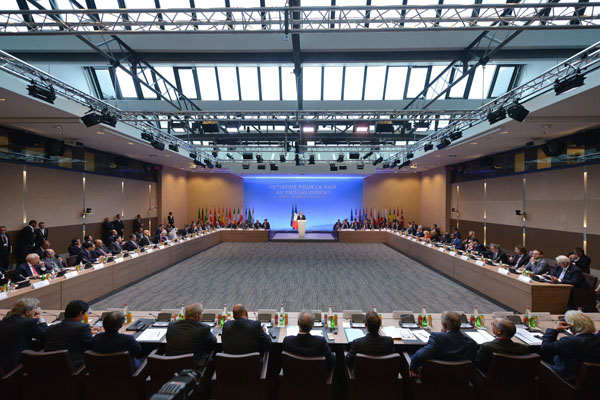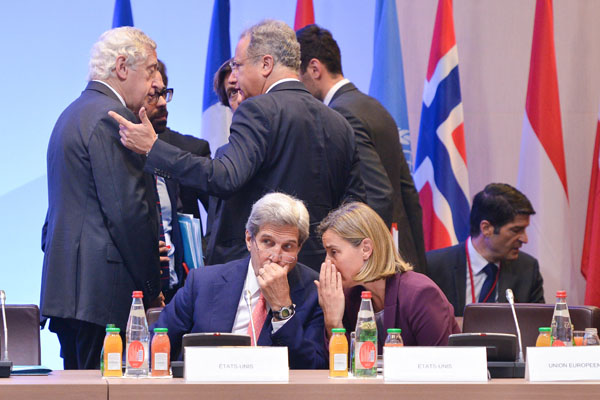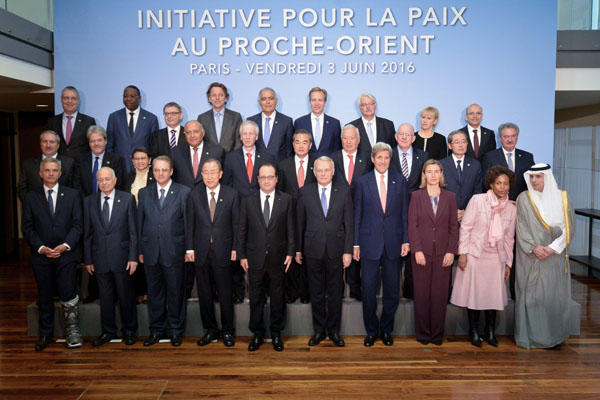The Prime Minister’s Office spared no time in declaring the multilateral conference on advancing Mideast peace a failure. He may have missed a few things.
By Shemuel Meir

It is difficult to ignore the unbridled joy that took over the Prime Minister’s Office as its spokespeople went out of their way to declare the Paris peace summit, which took place this past weekend, a failure. Their proof? A “shallow” final statement that included neither a defined time table (for further international involvement? For Israeli withdrawal from the West Bank?) and did not mention “1967 lines.”
The spokespeople patted themselves on the shoulder, hinting that what they viewed as a meager outcome of the Paris Summit stemmed from Israel’s global diplomatic efforts. A summit of 29 foreign ministers who discussed the Israeli-Palestinian conflict was presented as another “photo op” and a PR stunt by France.
Israeli commentators and political correspondents tended to accept the PMO’s version as is, which was then reflected in their writing in the Israeli media. But a closer examination of the summit and the declarations made by leading foreign ministers who participated paints an entirely different picture. There is no factual basis for the PMO’s elation.
Even the Prime Minister’s Office’s attempt to portray the failure in Paris as a “historic mistake” by enlisting the 1916 Sykes-Picot Agreement looks baseless. The relevance of the comparison is unclear, as is the reasoning for using phrases such as “the Sykes-Picot diktat.” Perhaps it was an attempt to coin a new, catchy phrase, such as the “appeasing Munich Conference,” which starred in the government’s fear-mongering hasbara efforts vis-à-vis the Iranian nuclear issue.
I will try to separate the truth from the background noise, in order to lay out a framework for a public discussion based on facts, rather than metaphors.

The closing statement published at the end of the summit, which included U.S. Secretary of State John Kerry, was short and straightforward. The text defined the summit’s main goal — the two-state solution — and established that the status quo was unsustainable. In doing so the participants rejected the prime minister’s conflict management doctrine. The foreign ministers were “alarmed by the actions on the ground,” in particular continued acts of violence and settlement activity. They did not accept the Israeli position that Palestinian terror and rejectionism is at the base of the conflict. According to the statement the goal is, “fully ending the occupation that began in 1967.” This is a quote from a statement backed by the United States, not some marginal leftist group.
According to the statement Israeli-Palestinian peace will be based on United Nations Security Council Resolution 242, which forms the core of Israel’s peace agreements with Egypt and Jordan, as well as the Oslo Accords. The important part of Resolution 242 is its preamble, which forbids the military annexation of territory. This norm has been established in international relations as a lesson from World War II.
The text does not directly mention “1967 lines,” yet it does address them in several ways: calling for an end to the occupation that began in 1967, relying on Resolution 242 and the positive sentiment toward the Saudi-backed Arab Peace Initiative. The latter is a package deal: a sovereign Palestinian state alongside the State of Israel based on 1967 lines, in exchange for peace agreements and normalization between Israel and the rest of the Arab states.
The Arab Peace Initiative also provides a solution for the return of Palestinian refugees. The solution will be “just” and “agreed upon.” The words “agreed upon” gave Israel the right to veto the return of Palestinian refugees to Israeli territory. For the first time, Israel’s stance against the right of return received international approval.

The final paragraph of the closing statement looks toward the near future and focuses on practical steps for promoting Israeli-Palestinian peace. After declaring that the world powers have no intention of imposing a deal on both sides, and that the conflict will come to an end through either direct or regional negotiations (as per Israel’s demand), international groups can step up to the plate. The Quartet (made up of the U.S., E.U., Russia, and the U.N.), regional players, and states which seek to contribute are all welcome to take part in the process. France will be responsible for coordinating the international summit by the end of the year. The Israeli government should be paying attention, after it openly spoke with disdain against France’s intention of holding a summit in June 2016 (and did not act until nearly the very last moment).
The Paris summit converged with a sense of urgency, and out of a deep worry for the end of the two-state solution. In an interview with Le Monde, French Foreign Minister Jean Marc Ayrault called the political stalemate a recipe for disaster. According to Ayrault and EU foreign policy chief Federica Mogherini, at the end of discussions it was made clear that continuing the pointless brawling between Israel and the Palestinians is not an option. When asked by a journalist about Israel Foreign Ministry Director-General Dore Gold’s comparison to Sykes-Picot, Mogherini responded that without an international framework the two sides are not going to just spontaneously make their way to the negotiating table. Thus there is a need to create an international plan that will be implemented alongside the direct and regional negotiations between the sides — a kind of responsible adult that will aid the two sides in seriously and bravely moving forward.
In this sense, the Paris Peace Summit is the first step toward launching an international mechanism whose details have yet to be agreed upon. One option is the dual model of direct negotiations under the auspices of an international mechanism, along the lines of the Madrid Conference in 1991. Former Secretary of State James Baker, who took part in that conference, was able to bring all sides to the table, despite the opposition of then Israeli prime minister Yitzhak Shamir. Another option is the dual model that brought about the end of the civil war in Yugoslavia. A third option is P5+1 model of talks, which brought about the resolution to the Iranian nuclear conflict. Here I mean adopting a model of deep involvement and tight coordination between the United States and the European Union. In that scenario, the U.S. would supply the security guarantees for Israeli-Palestinian peace, while the E.U. will provide the economic advantages and bonuses.
In any event, and due to the sense of urgency that pervaded the conference, it doesn’t seem like they are going to let the issue die. There are signs that the U.S. and France are coordinated, and it seems that France got the green light to continue from the point where Kerry’s peace initiative died in 2014. We will need to wait and see what appears in the Quartet report slated for release this month.
In Paris we saw the formation of an international mechanism to accompany the Israeli-Palestinian conflict, which includes the Arab Peace Initiative. The active participation of Saudi Arabia and Egypt in the French initiative drove a stake through the Israeli idea of a “bypass road.” Talks of “el-Sissi’s initiative” had no factual basis, and they likely originated in internal political spin whose goal was to broaden the coalition.
The Saudi foreign minister also made sure to pull the rug out from under the “positive components” that Netanyahu suddenly discovered in the Arab Peace Initiative. Few noticed that Netanyahu meant to enter negotiations based on “updating” the Saudi initiative, and not based on its original principles. The Saudi foreign minister did notice. It seems the Saudis prefer the French initiative (which includes the Arab Peace Initiative) and have no interest in entering long-term negotiations on procedures, since it is unclear how and when doing so would lead to negotiations on the real issues.
Shemuel Meir is a former IDF analyst and associate researcher at the Jaffee Center for Strategic Studies at Tel Aviv University. Today he is an independent researcher on nuclear and strategic issues and author of the “Strategic Discourse” blog, which appears in Haaretz.
